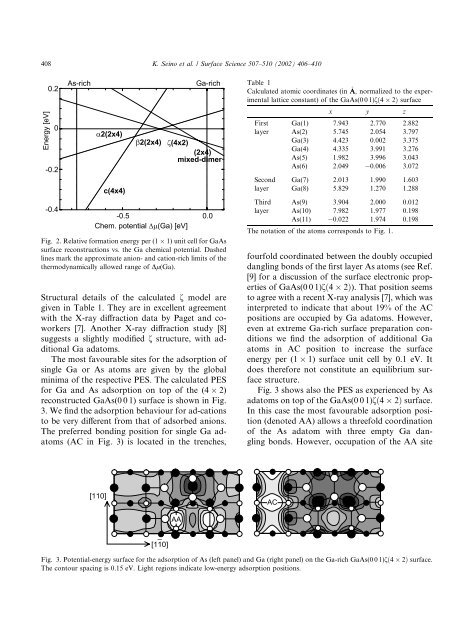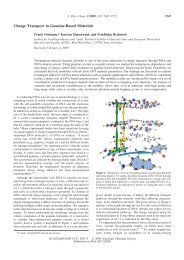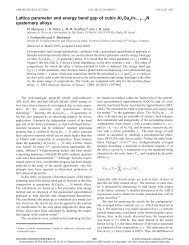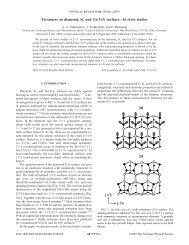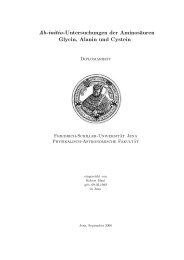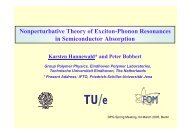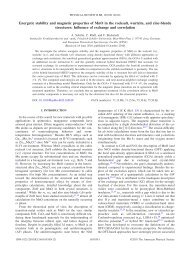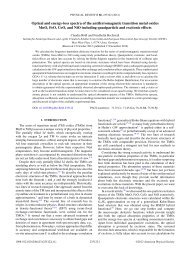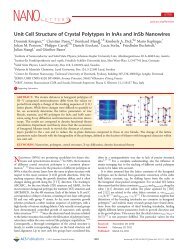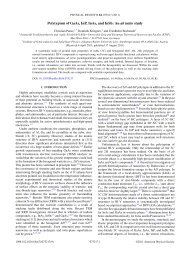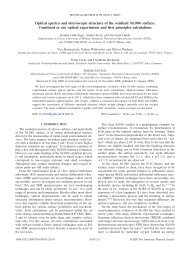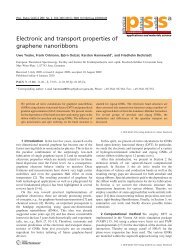Structure and energetics of Ga-rich GaAs(001) surfaces - Institut für ...
Structure and energetics of Ga-rich GaAs(001) surfaces - Institut für ...
Structure and energetics of Ga-rich GaAs(001) surfaces - Institut für ...
You also want an ePaper? Increase the reach of your titles
YUMPU automatically turns print PDFs into web optimized ePapers that Google loves.
408 K. Seino et al. / Surface Science 507–510 (2002) 406–410<br />
Table 1<br />
Calculated atomic coordinates (in A, normalized to the experimentallattice<br />
constant) <strong>of</strong> the <strong>Ga</strong>As(0 0 1)fð4 2Þ surface<br />
x y z<br />
First<br />
layer<br />
<strong>Ga</strong>(1) 7.943 2.770 2.882<br />
As(2) 5.745 2.054 3.797<br />
<strong>Ga</strong>(3) 4.423 0.002 3.375<br />
<strong>Ga</strong>(4) 4.335 3.991 3.276<br />
As(5) 1.982 3.996 3.043<br />
As(6) 2.049 0.006 3.072<br />
Second<br />
layer<br />
<strong>Ga</strong>(7) 2.013 1.990 1.603<br />
<strong>Ga</strong>(8) 5.829 1.270 1.288<br />
Fig. 2. Relative formation energy per (1 1) unit cell for <strong>Ga</strong>As<br />
surface reconstructions vs. the <strong>Ga</strong> chemicalpotential. Dashed<br />
lines mark the approximate anion- <strong>and</strong> cation-<strong>rich</strong> limits <strong>of</strong> the<br />
thermodynamically allowed range <strong>of</strong> Dl(<strong>Ga</strong>).<br />
Structural details <strong>of</strong> the calculated f modelare<br />
given in Table 1. They are in excellent agreement<br />
with the X-ray diffraction data by Paget <strong>and</strong> coworkers<br />
[7]. Another X-ray diffraction study [8]<br />
suggests a slightly modified f structure, with additional<strong>Ga</strong><br />
adatoms.<br />
The most favourable sites for the adsorption <strong>of</strong><br />
single <strong>Ga</strong> or As atoms are given by the global<br />
minima <strong>of</strong> the respective PES. The calculated PES<br />
for <strong>Ga</strong> <strong>and</strong> As adsorption on top <strong>of</strong> the (4 2)<br />
reconstructed <strong>Ga</strong>As(0 0 1) surface is shown in Fig.<br />
3. We find the adsorption behaviour for ad-cations<br />
to be very different from that <strong>of</strong> adsorbed anions.<br />
The preferred bonding position for single <strong>Ga</strong> adatoms<br />
(AC in Fig. 3) is located in the trenches,<br />
Third<br />
layer<br />
As(9) 3.904 2.000 0.012<br />
As(10) 7.982 1.977 0.198<br />
As(11) 0.022 1.974 0.198<br />
The notation <strong>of</strong> the atoms corresponds to Fig. 1.<br />
fourfold coordinated between the doubly occupied<br />
dangling bonds <strong>of</strong> the first layer As atoms (see Ref.<br />
[9] for a discussion <strong>of</strong> the surface electronic properties<br />
<strong>of</strong> <strong>Ga</strong>As(0 0 1)fð4 2Þ). That position seems<br />
to agree with a recent X-ray analysis [7], which was<br />
interpreted to indicate that about 19% <strong>of</strong> the AC<br />
positions are occupied by <strong>Ga</strong> adatoms. However,<br />
even at extreme <strong>Ga</strong>-<strong>rich</strong> surface preparation conditions<br />
we find the adsorption <strong>of</strong> additional<strong>Ga</strong><br />
atoms in AC position to increase the surface<br />
energy per (1 1) surface unit cell by 0.1 eV. It<br />
does therefore not constitute an equilibrium surface<br />
structure.<br />
Fig. 3 shows also the PES as experienced by As<br />
adatoms on top <strong>of</strong> the <strong>Ga</strong>As(0 0 1)fð4 2Þ surface.<br />
In this case the most favourable adsorption position<br />
(denoted AA) allows a threefold coordination<br />
<strong>of</strong> the As adatom with three empty <strong>Ga</strong> dangling<br />
bonds. However, occupation <strong>of</strong> the AA site<br />
Fig. 3. Potential-energy surface for the adsorption <strong>of</strong> As (left panel) <strong>and</strong> <strong>Ga</strong> (right panel) on the <strong>Ga</strong>-<strong>rich</strong> <strong>Ga</strong>As(0 0 1)fð4 2Þ surface.<br />
The contour spacing is 0.15 eV. Light regions indicate low-energy adsorption positions.


